 Enhancing your appearance with scar revision surgery
Enhancing your appearance with scar revision surgery
Scars are visible signs that remain after a wound has healed. They are unavoidable results of injury or surgery, and their development can be unpredictable. Poor healing may contribute to scars that are obvious, unsightly or disfiguring. Even a wound that heals well can result in a scar that affects your appearance. Scars may be raised or recessed, different in color or texture from surrounding healthy tissue or particularly noticeable due to their size, shape or location.
Your treatment options may vary based on the type and degree of scarring and can include:
- Simple topical treatments
- Minimally invasive procedures
- Surgical revision with advanced techniques in wound closure
Scar revision surgery is meant to minimize the scar so that it is more consistent with your surrounding skin tone and texture.
Although scar revision can provide a more pleasing cosmetic result or improve a scar that has healed poorly, a scar cannot be completely erased.
Is it right for me?
Scar revision is a highly individualized procedure and you should do it for yourself, not to fulfill someone else’s desires or to try to fit any sort of ideal image. Scar revision can be performed on people of any age and is a good option for you if:
- You are bothered by a scar anywhere on your body
- You are physically healthy
- You do not smoke
- You have a positive outlook and realistic goals for your scar revision surgery
- You do not have active acne or other skin diseases in the area to be treated
Scar revision is plastic surgery performed to improve the condition or appearance of a scar anywhere on your body. The different types of scars include:
Discoloration, surface irregularities and other more subtle scars can be cosmetically improved by surgery or other treatments recommended by your plastic surgeon. These types of scars do not impair function or cause physical discomfort and include acne scars as well as scars resulting from minor injury and prior surgical incisions.

Hypertropic scars are thick clusters of scar tissue that develop directly at a wound site. They are often raised, red and/or uncomfortable, and they may become wider over time. They can be hyperpigmented (darker in color) or hypopigmented (lighter in color).
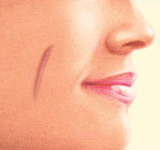
Keloids are larger than hypertropic scars. They can be painful or itchy, and may also pucker. They extend beyond the edges of an original wound or incision. Keloids can occur anywhere on your body, but they develop more commonly where there is little underlying fatty tissue, such as on the face, neck, ears, chest or shoulders.
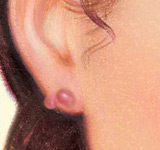
Contractures are scars that restrict movement due to skin and underlying tissue that pull together during healing. They can occur when there is a large amount of tissue loss, such as after a burn. Contractures also can form where a wound crosses a joint, restricting movement of the fingers, elbows, knees or neck.
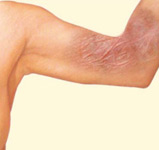
The type of scar you have will determine the appropriate techniques your plastic surgeon will use to improve your scar.
The success and safety of your scar revision procedure depends very much on your complete candidness during your consultation. You’ll be asked a number of questions about your health, desires and lifestyle.
Be prepared to discuss:
- Why you want the surgery, your expectations and desired outcome
- Medical conditions, drug allergies and medical treatments
- Use of current medications, vitamins, herbal supplements, alcohol, tobacco and drugs
- Previous surgeries
Your surgeon may also:
- Evaluate your general health status and any pre-existing health conditions or risk factors
- Examine your scar in detail
- Take photographs for your medical record
- Discuss your options and recommend a course of treatment
- Discuss likely outcomes and any risks or potential complications
Prior to surgery, you may be asked to:
- Get lab testing or a medical evaluation
- Take certain medications or adjust your current medications
- Stop smoking well in advance of surgery
- Avoid taking aspirin and certain anti-inflammatory drugs and herbal supplements as they can increase bleeding
Special instructions you receive will cover:
- What to do on the day of surgery
- The use of anesthesia during your procedure
- Post-operative care and follow-up
Step 1 –Anesthesia
Medications are administered for your comfort during the surgical procedures. The choices include local anesthesia, intravenous sedation and general anesthesia. Your doctor will recommend the best choice for you.
Step 2 – The treatment
The degree of improvement that can be achieved with scar revision will depend on the severity of your scarring, and the type, size and location of the scar. In some cases, a single technique may provide significant improvement. However, your plastic surgeon may recommend a combination of scar revision techniques to achieve the best results.
Topical treatments, such as gels, tapes or external compression, can help in wound closure and healing, or to reduce the ability of skin to produce irregular pigment. These products may be used to treat existing surface scars and discoloration, and to aid in healing of scar revision procedures.
Injectable treatments are often used to fill depressed or concave scars. Depending on the injectable substance used and your particular scar conditions, results may last from three months to several years. Therapy must be repeated to maintain results. One form of injection therapy uses steroidal-based compounds to reduce collagen formation and can alter the appearance, size and texture of raised scar tissue.
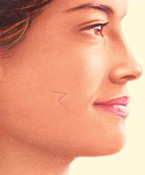

Surface treatments are most often used for cosmetic improvement of scars. These methods can soften surface irregularities and reduce uneven pigmentation. Surface treatments are a controlled means of either mechanically removing the top layers of skin or changing the nature of tissue. These treatment options include:
- Dermabrasion is a mechanical polishing of the skin.
- Laser or light therapy causes changes to the surface of the skin that allow new, healthy skin to form at the scar site.
- Chemical peel solutions penetrate the skin’s surface to soften irregularities in texture and color.
- Skin bleaching agents are medications applied topically to lighten the skin.


Step 3 – Sometimes for deeper scars an incision is needed to surgically remove the old scar.
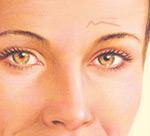
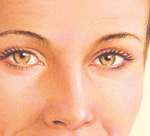
Step 4 – Closing the incisions:
Some scars require layered closure. Layered closure is often used where excision extends to tissue below the skin surface or in areas with a high degree of movement. The first step, or layer, requires sub-dermal closure (below the skin surface) with absorbable or non-removable sutures. Layers of closure continue to build, concluding with closure of the remaining surface wound.
Advanced techniques in scar revision include complex flap closure to reposition a scar so that it is less conspicuous, or improve flexibility where contracture has restricted mobility.
Pharmaceutical tissue substitutes may be used if ample healthy tissue is not present for closure of a scar excision. This is more likely with revision of severe burn scars.
Tissue expansion can be a substitute for skin grafts. In this procedure, an inflatable balloon called a tissue expander is placed under the skin near the scar site. Over time, the balloon is slowly filled with sterile solution to expand the area of healthy skin. Once the skin has been stretched sufficiently, the expander and the scar is removed and the stretched skin is moved to replace the scar tissue. This process can involve multiple surgical stages or procedures in order to achieve the final results.
The decision to have scar revision surgery is extremely personal and you’ll have to decide if the benefits will achieve your goals and if the risks and potential complications are acceptable. Your plastic surgeon and/or staff will explain in detail the risks associated with surgery.
You will be asked to sign consent forms to ensure that you fully understand the procedure you will undergo, the alternatives and the most likely risks and potential complications.
Some of the risks include:
- Bleeding (hematoma)
- Infection
- Delayed healing
- Anesthesia risks
- Change in skin sensation
- Damage to deeper structures including nerves, blood vessels, muscles and lungs can occur and may be temporary or permanent
- Allergies to tape, suture materials and glues, blood products, topical preparations or injected agents
- Skin contour irregularities
- Skin discoloration and swelling
- Skin sensitivity
- Deep vein thrombosis, cardiac and pulmonary complications
- Pain, which may persist
- Possibility of revisional surgery or staged procedures
Be sure to ask questions: It’s very important to ask your plastic surgeon questions about your procedure. It’s natural to feel some anxiety, whether it’s excitement for your anticipated new look or a bit of preoperative stress. Don’t be shy about discussing these feelings with your plastic surgeon.
Where will my surgery be performed?
Scar revision surgery may be performed in your plastic surgeon’s office, accredited office-based surgical facility, an ambulatory surgical facility or a hospital. Your plastic surgeon and the assisting staff will fully attend to your comfort and safety.
When your procedure is finished, bandages or dressings may be applied to keep the surgical site clean.
You will be given specific instructions that may include: How to care for yourself following surgery, medications to apply or take orally to aid healing and reduce the risk of infection, and when to follow-up with your plastic surgeon.
When you go home
If you experience shortness of breath, chest pains, or unusual heart beats, seek medical attention immediately. Should any of these complications occur, you may require hospitalization and additional treatment.
Be careful
Following your physician’s instructions is key to the success of your surgery. It is important that the surgical incisions are not subjected to excessive force, abrasion, or motion during the time of healing. Your doctor will give you specific instructions on how to care for yourself.
Follow all postoperative instructions carefully, including cleansing and at-home treatment regimens, and avoid sun exposure. Your cooperation will influence the outcome of your surgery.
Progress and healing
The initial healing phase of a surgical scar revision may include localized swelling, discoloration or discomfort and may take 1 to 2 weeks. Healing will continue for several weeks and as the new scar heals it will slowly refine and fade. With dermabrasion, chemical peel or laser resurfacing, you will experience similar conditions at the treated area, in addition to overall sensitivity.
 The results will be long-lasting
The results will be long-lasting
The final results of your scar revision surgery will be long-lasting, however it may take several months for your final results to become apparent and in some cases it may take a year for the new scar to fully heal and fade.
The practice of medicine and surgery is not an exact science. Although good results are expected, there is no guarantee, in some situations, it may not be possible to achieve optimal results with a single surgical procedure and another surgery may be necessary.
Cost is always a consideration in elective surgery. Prices for scar revision procedures can vary widely. A surgeon’s cost for scar revision may vary based on his or her experience, the type of procedure used, as well as geographic location. Many plastic surgeons offer patient financing plans, so be sure to ask.
Cost may include:
- Surgeon’s fee
- Hospital or surgical facility costs
- Anesthesia fees
- Prescriptions for medication
- Post-surgery garments
- Medical tests
Most health insurance plans will not cover scar revision surgery, related complications or another surgery to revise the appearance of your scar. You must carefully review your health insurance policy.
 Your satisfaction involves more than a fee
Your satisfaction involves more than a fee
When choosing a plastic surgeon for scar revision surgery, remember that the surgeon’s experience and your comfort with him or her are just as important as the final cost of the surgery.
- Chemical peel solutions: Substances that penetrate the skin’s surface to soften irregularities in texture and color.
- Contractures: Scars that restrict movement due to skin and underlying tissue that pull together during healing and usually occur when there is a large amount of tissue loss, such as after a burn.
- Dermabrasion: Mechanical polishing of the skin.
- Excision: Surgical removal of a scar.
- General anesthesia: Drugs and gases used during an operation to relieve pain and alter consciousness.
- Hyperpigmented scar: A scar that is darker in color.
- Hypertropic scar: Thick clusters of scar tissue that develop directly at a wound site.
- Hypopigmented scar: A scar that is lighter in color.
- Intravenous sedation: Sedatives administered by injection into a vein to help you relax.
- Keloids: Large scars that can be painful or itchy, and may also pucker which can occur anywhere on your body, developing more commonly where there is little underlying fatty tissue, such as on the breastbone or shoulders.
- Laser resurfacing: A method to change to the surface of the skin that allows new, healthy skin to form at the scar site.
- Light therapy: (Intense Pulsed Light) Pulses of light that can be used to treat discoloration and texture changes of the skin.
- Local anesthesia: A drug injected directly to the site of an incision during an operation to relieve pain.
- Skin grafts: Healthy skin taken from other areas of your body, such as the abdomen or thigh, to revise a scar.
- Tissue expansion: A procedure that can substitute for skin grafts. An inflatable balloon called a tissue expander is placed under the skin near the scar site to stretch additional skin to be used to revise a scar. Oftentimes, multiple procedures are needed.
- Z-plasty: A surgical technique that creates angled flaps on either side of the original scar site that can completely reposition or change scar direction, interrupt scar tension or improve scar flexibility.
Use this checklist as a guide during your consultation
- Are you certified by the American Board of Plastic Surgery?
- Were you trained specifically in the field of plastic surgery?
- How many years of plastic surgery training have you had?
- Do you have hospital privileges to perform this procedure? If so, at which hospitals?
- Is the office-based surgical facility accredited by a nationally- or state-recognized accrediting agency, or is it state-licensed or Medicare-certified?
- How many procedures of this type have you performed?
- Am I a good candidate for this procedure?
- Where and how will you perform my procedure?
- How long of a recovery period can I expect, and what kind of help will I need during my recovery?
- What are the risks and complications associated with my procedure?
- How are complications handled?
- What are my options if I am dissatisfied with the cosmetic outcome of my scar revision surgery?
- Do you have before-and-after photos I can look at for each procedure and what results are reasonable for me?
Plastic surgery involves many choices. The first and most important is selecting a surgeon you can trust.
Choosing an ASPS Member Surgeon ensures that you have selected a physician who:
- Has completed at least five years of surgical training with a minimum of two years in plastic surgery.
- Is trained and experienced in all plastic surgery procedures, including breast, body, face and reconstruction.
- Operates only in accredited medical facilities
- Adheres to a strict code of ethics.
- Fulfills continuing medical education requirements, including standards and innovations in patient safety.
- Is board certified by The American Board of Plastic Surgery or in Canada by the Royal College of Physicians and Surgeons of Canada®.
ASPS Member Surgeons are your partners in cosmetic and reconstructive plastic surgery.
Look for the ASPS Member Surgeon logo.

 3510 N. Ridge Rd, Suite 100
3510 N. Ridge Rd, Suite 100